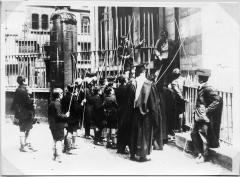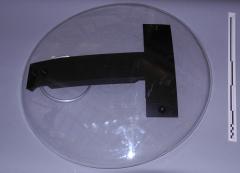ENGLAND: THE OTHER WITHIN
Analysing the English Collections at the Pitt Rivers Museum
Ethnographic Objects from Oxford
Alison Petch,
Researcher 'The Other Within' project
A total of 929 ethnographic artefacts from Oxford in Oxfordshire are owned by the Pitt Rivers Museum. These artefacts have been accessioned since 1884 when the Museum was founded. This is by far the largest single set of artefacts from an Oxfordshire settlement in the Museum.
City of Oxford the place
Environment
Oxford is the county town of Oxfordshire, it lies roughly sixty miles west of London. Two rivers flow through it, the Thames (known in the city as the Isis), and the River Cherwell. It is the home of the University of Oxford, of which the Pitt Rivers Museum is a part. The city is known as the 'city of dreaming spires', because of the high standard of architecture in the buildings in the centre of the city, particularly those owned by the University. It is surrounded by suburbs and green space (like Port Meadow), and some (motor) industry (mostly to the south of the city, in Cowley).

1965.5.1 .241 Beating the bounds, Sheldonian Theatre Broad Street, Oxford. Photographer R.R. Martin, donated Ellen Ettlinger
Population
Oxford had a resident population of over 134,000 in 2001. The population in 2006 had been estimated to have increased to 149,100. 26 per cent of the working age population are students, the highest proportion in England and Wales. Over 30,000 students study at Oxford University and Oxford Brookes University. Oxford has a slightly higher than average 'ethnic minority' population (12.9 per cent compared to 8.7 per cent for England and Wales). Oxford is said to have the second highest proportion of people born outside the UK in the South East. Many workers commute into Oxford each day because Oxford is a very expensive place to live. The population of Oxford increased very rapidly at the beginning of the twentieth century when industry first arrived in Oxford, in 1911 the population was 23,224, but by 1931 it was 80,539.
Further reading
http://www.oxford.gov.uk/community/popnstats.cfm
http://www.visionofbritain.org.uk/place/place_page.jsp?p_id=887&st=oxford
http://en.wikipedia.org/wiki/Oxford
http://neighbourhood.statistics.gov.uk/dissemination/LeadDomainList.do?a=3&c=oxford&d=13&i=1001x1002&m=0&r=1&s=1210692997726&enc=1&areaId=277086&OAAreaId=480474
http://www.british-history.ac.uk/report.aspx?compid=22802&strquery=oxford
Ethnographic collections
Some of the items from Oxford have more detailed provenances than just that they are from the City. Of those that do here are the areas (mostly suburbs) they come from:Binsey 3
Botley 2
Cowley 13
Headington 22
Iffley 1
Jericho 2
North Hinksey 3
St Ebbe's 3
Wolvercote 2
Not all of these are included in Oxford City Council's adminstrative boundaries (so are not included in the Oxford statistics given elsewhere, but they do form part of Oxford's settlement.
3 objects come from the annual St Giles fair. A total of 11 objects come from Headington Quarry, including 6 short sticks used by the Headington Quarry Morris side in their stick dances, and other Morris paraphenalia. To find all the objects held in the Pitt Rivers Museum from Oxford search for English town: Oxford.
See also University of Oxford objects.
